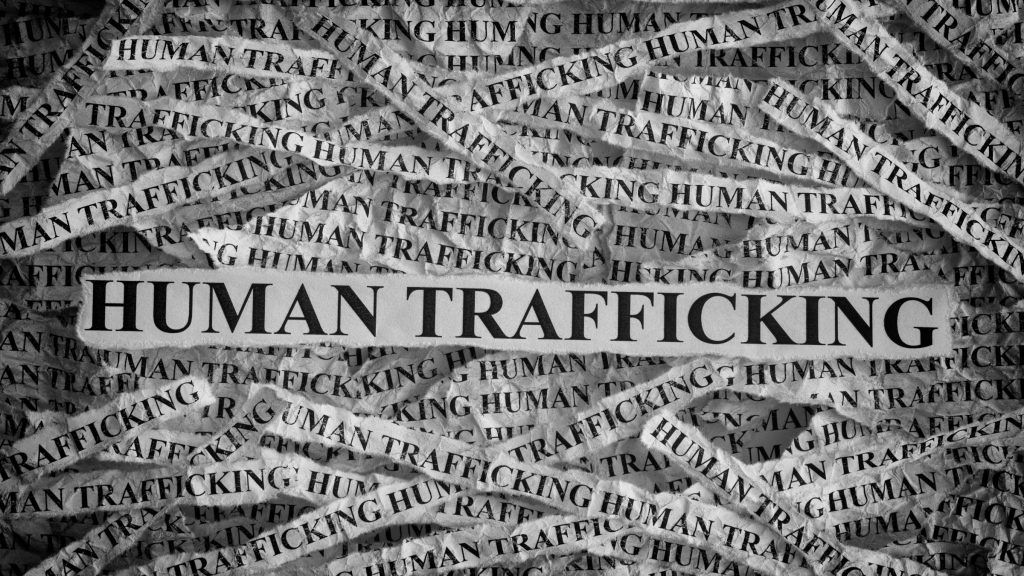| CARVIEW |

- About
- Divisions
- Initiatives
- Actual Innocence Program
- Anti-Bullying Efforts
- Common Interest Community (HOA) Ombudsperson
- Foreclosure Prevention
- Impact Litigation
- Manufactured Housing
- Mortgage Mediation Program
- Nuisance Abatement
- Office of Immigration Assistance (Oficina de Asistencia de Inmigración)
- Open Doors Project
- Senior Protection Initiative
- Victims’ Compensation Assistance Program
- Resources
- Transparency
- Contact
- Join Us
Delaware Department of Justice
Attorney General
Kathy Jennings
Human Trafficking
National Human Trafficking Hotline: 1 (888) 373-7888 | Polaris BeFree Textline: Text “BeFree” to (233733)
Human trafficking, according to the National Human Trafficking Hotline, “is a form of modern-day slavery in which traffickers use force, fraud, or coercion to control victims for the purpose of engaging in commercial sex acts or labor services against his/her will.” Working with law enforcement and advocacy partners, the Delaware Department of Justice has prosecuted human traffickers in Delaware and shut down businesses found or suspected to be engaging in human trafficking.
Take action by informing yourself, your friends and family and your community about human trafficking. Read about the definitions, facts, current laws and legislation, and resources to escape human trafficking or to report it. Know the signs – It could save someone’s life.
According to the Polaris Project, “Human trafficking is a form of modern slavery—a multi-billion dollar criminal industry that denies freedom to 20.9 million people around the world. And no matter where you live, chances are it’s happening nearby. From the girl forced into prostitution at a truck stop, to the man discovered in a restaurant kitchen, stripped of his passport and held against his will. All trafficking victims share one essential experience: the loss of freedom.”
According to the National Human Trafficking Hotline, “Human trafficking is a crime involving the exploitation of someone for the purposes of compelled labor or a commercial sex act through the use of force, fraud, or coercion. Human trafficking affects individuals across the world, including here in the United States, and is commonly regarded as one of the most pressing human rights issues of our time. Human trafficking affects every community in the United States across age, gender, ethnicity, and socio-economic backgrounds. ”
Human trafficking includes sex trafficking and labor trafficking.
Sex Trafficking:
According to the Polaris Project, “Sex trafficking is a form of modern slavery that exists throughout the United States and globally. Sex traffickers use violence, threats, lies, debt bondage, and other forms of coercion to compel adults and children to engage in commercial sex acts against their will. Under U.S. federal law, any minor under the age of 18 years induced into commercial sex is a victim of sex trafficking—regardless of whether or not the trafficker used force, fraud, or coercion.”
According to the National Human Trafficking Hotline, “Sex trafficking is the recruitment, harboring, transportation, provision, obtaining, patronizing, or soliciting of a person for the purposes of a commercial sex act, in which the commercial sex act is induced by force, fraud, or coercion, or in which the person induced to perform such an act has not attained 18 years of age (22 USC § 7102).”
Labor Trafficking:
According to the Polaris Project, “Labor trafficking is a form of modern slavery that exists throughout the United States and globally. Labor traffickers – including recruiters, contractors, employers, and others – use violence, threats, lies, debt bondage, or other forms of coercion to force people to work against their will in many different industries. Labor traffickers often make false promises of a high-paying job or exciting education or travel opportunities to lure people into horrendous working conditions. Yet, victims find that the reality of their jobs proves to be far different than promised and must frequently work long hours for little to no pay. Their employers exert such physical or psychological control – including physical abuse, debt bondage, confiscation of passports or money – that the victim believes they have no other choice but to continue working for that employer.”
According to the National Human Trafficking Hotline, “the Trafficking Victims Protection Act of 2000 (TVPA) defines labor trafficking as: “The recruitment, harboring, transportation, provision, or obtaining of a person for labor or services, through the use of force, fraud or coercion for the purpose of subjection to involuntary servitude, peonage, debt bondage or slavery” (22 USC § 7102(9)).””
To effectively combat human trafficking, each of us needs to have a clear “lens” that helps us understand what human trafficking is. When this lens is clouded or biased by misconceptions about the definition of trafficking, our ability to respond to the crime is reduced. It is important to learn how to identify and break down commonly-held myths and misconceptions regarding human trafficking and the type of trafficking networks that exist in the United States.
Learn about the myths and misconceptions regarding human trafficking HERE.
Although slavery is commonly thought to be a thing of the past, human traffickers generate hundreds of billions of dollars in profits by trapping millions of people in horrific situations around the world, including here in the U.S. Traffickers use violence, threats, deception, debt bondage, and other manipulative tactics to force people to engage in commercial sex or to provide labor or services against their will. While more research is needed on the scope of human trafficking, below are a few key statistics:
The International Labour Organization estimates that there are 20.9 million victims of human trafficking globally.
- 68% of them are trapped in forced labor.
- 26% of them are children.
- 55% are women and girls, meaning 45% are boys and men.
The International Labor Organization estimates that forced labor and human trafficking is a $150 billion industry worldwide.
The U.S. Department of Labor has identified 139 goods from 75 countries made by forced and child labor.
In 2016, an estimated 1 out of 6 endangered runaways reported to the National Center for Missing and Exploited Children were likely child sex trafficking victims.
- Of those, 86% were in the care of social services or foster care when they ran.
There is no official estimate of the total number of human trafficking victims in the U.S. Polaris estimates that the total number of victims nationally reaches into the hundreds of thousands when estimates of both adults and minors and sex trafficking and labor trafficking are aggregated.
Statistics from the National Human Trafficking Hotline and Polaris BeFree Textline
- More than 31,600 total cases of human trafficking have been reported to the Hotline in the last eight years.
- The Hotline annually receives multiple reports of human trafficking cases in each of the 50 states and D.C. Read more Hotline statistics here.
- The number of human trafficking cases that Polaris learns about in the U.S. increases every year. Review our 2016 statistics fact sheet here.
- 23% of texting conversations on the Polaris BeFree Textline were from survivors of human trafficking compared to 11% of phone calls on the Hotline. Read Polaris BeFree Textline statistics here.
- The Hotline receives an average of 100 calls per day. Read stories of survivors who called the hotline for help.
These facts were compiled from The Polaris Project and the National Human Trafficking Hotline.
Are you or someone you know being trafficked? Is human trafficking happening in your community? Recognizing potential red flags and knowing the indicators of human trafficking is a key step in identifying more victims and helping them find the assistance they need.
To request help or report suspected human trafficking, call the National Human Trafficking Hotline at 1-888-373-7888 or text “HELP” to: BeFree (233733).
Common Work and Living Conditions: The individual(s) in question
- Is not free to leave or come and go as he/she wishes
- Is under 18 and is providing commercial sex acts
- Is in the commercial sex industry and has a pimp / manager
- Is unpaid, paid very little, or paid only through tips
- Works excessively long and/or unusual hours
- Is not allowed breaks or suffers under unusual restrictions at work
- Owes a large debt and is unable to pay it off
- Was recruited through false promises concerning the nature and conditions of his/her work
- High security measures exist in the work and/or living locations (e.g. opaque windows, boarded up windows, bars on windows, barbed wire, security cameras, etc.)
Poor Mental Health or Abnormal Behavior
- Is fearful, anxious, depressed, submissive, tense, or nervous/paranoid
- Exhibits unusually fearful or anxious behavior after bringing up law enforcement
- Avoids eye contact
Poor Physical Health
- Lacks health care
- Appears malnourished
- Shows signs of physical and/or sexual abuse, physical restraint, confinement, or torture
Lack of Control
- Has few or no personal possessions
- Is not in control of his/her own money, no financial records, or bank account
- Is not in control of his/her own identification documents (ID or passport)
- Is not allowed or able to speak for themselves (a third party may insist on being present and/or translating)
Other
- Claims of just visiting and inability to clarify where he/she is staying/address
- Lack of knowledge of whereabouts and/or do not know what city he/she is in
- Loss of sense of time
- Has numerous inconsistencies in his/her story
This list is not exhaustive and represents only a selection of possible indicators. Also, the red flags in this list may not be present in all trafficking cases and are not cumulative. Learn more at www.humantraffickinghotline.org.
- Blue Lightning Initiative for Airline Personnel
- Human Trafficking Training Program for Law Enforcement
- Office of Justice Programs – Office for Victims of Crime (OVC)
- U.S. Customs and Border Protection – Human Trafficking Resources
- U.S. Admin. for Children & Families Office on Trafficking in Persons (OTIP)
- U.S. Citizenship and Immigration Services – Immigration Relief for Victims
- Report Trafficking
- Get Involved – Nat’l Human Trafficking Hotline
- Contact Congress – Polaris Project
- Act to End Slavery – End Slavery Now
- Take Action – Human Trafficking Search
- Act for Freedom – The Freedom Fund
- 10 Ways to Help End Trafficking – OTIP
- 15 Ways to Fight Trafficking – U.S. Dept. of State

Message and data rates may apply. Message frequency varies. Reply HELP for help or STOP to cancel at any time. Click here for Terms & Conditions and the Privacy Policy.
Delaware's Government
Delaware's Governor
State Directory
Elected Officials
General Assembly
Delaware Courts
State Employees
Cities & Towns
Delaware State Code
State Regulations
Business First Steps
Phone Directory
Locations Directory
Public Meetings
Voting & Elections
Transparency
Choose Health DE
Tax Center
Personal Income Tax
Privacy Policy
Weather & Travel
Contact Us
Corporations
Franchise Tax
Gross Receipts Tax
Withholding Tax
Guides to Services
Help Center
Mobile Apps
E-mail / Text Alerts
Social Media






